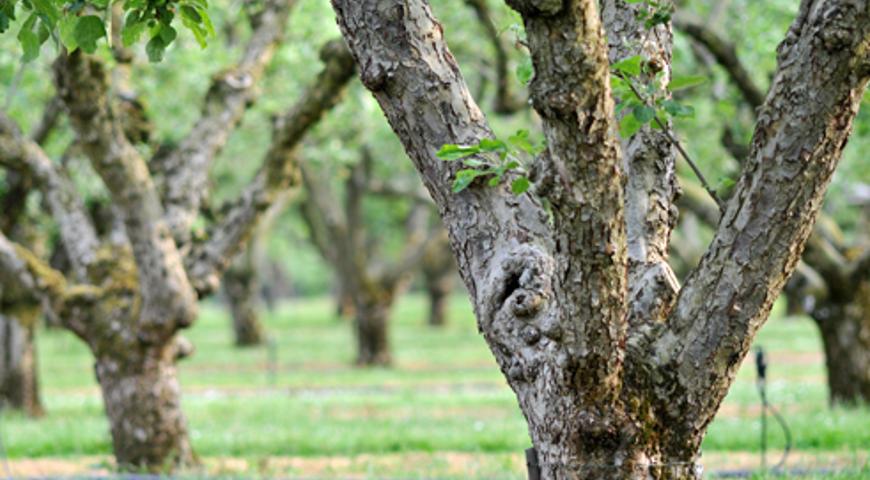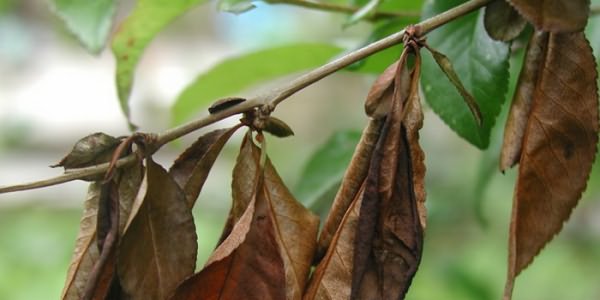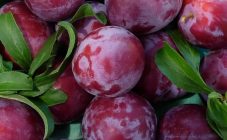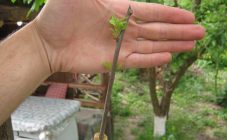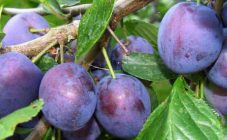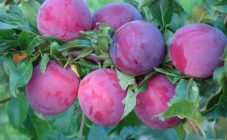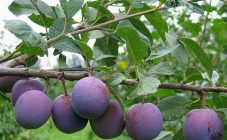Content:
Gardeners consider home plum to be one of the best stone fruit crops. The plant needs a lot of heat to form high-quality fruits. Therefore, the plum is considered predominantly a southern plant, little cultivated north of the Moscow region. Certain conditions are required to grow fruit trees. When the plum dries up, what to do becomes an urgent question for the summer resident.
Acceptable growing conditions
For the plum to bear fruit, it needs neighbors - pollinating varieties. As for the choice of soil, the culture in this regard is not particularly picky - any fertile land is suitable for it.
The culture is relatively drought resistant. But sometimes gardeners notice that the tree has begun to wither. In this case, the problem of how to save the plum from drying out must be solved immediately, using effective therapy.
Possible causes of wilting
Fruit trees wither for various reasons, this moment can come at any of the phases: after hibernation, during flowering and even at the time of fruit formation. Before proceeding with the treatment of a tree, it is necessary to establish why the branches near the plum (or leaves) are drying.
The plant wilts after flowering
The garden woke up after winter, dismissed the leaves, and suddenly a problem arose. The reason why the plum has bloomed and dried up may lie in an invasion of pests. Some feast on the nectar of flowers, others gnaw through the bark and penetrate into the branches.
This period also saw massive damage to trees by diseases. If preventive measures (spraying, feeding) were not taken in time, this may be the reason why the plum dries after flowering, the immunity of which is weakened by hibernation.
Withers after winter
The reason is why the plum dried up after winter, there may be a harsh climate (i.e. the plant is frozen over). If these are young seedlings, it is possible that varieties were selected incorrectly for planting - without taking into account the region. Even in the southern regions, sometimes trees, not having time to wake up after winter, begin to dry. Plants, weakened by fruiting, do not tolerate the cold well without autumn feeding.
In the root zone of trees, pests settle in order to winter comfortably. With the arrival of spring, they wake up and begin to feed on plant parts. The roots are especially actively affected during this period, which may cause the tree to die.
The plant did not come out of hibernation
Plum is considered to be a relatively winter-hardy crop, but it is often damaged by severe frosts (especially high-quality varieties). These fruit trees are among the first to wake up (after the cherry). If the buds do not swell by mid-April, it is necessary to revise the plant.
A dry trunk near a plum is a sign that it has suffered from frost. If the bark is "alive", there is hope that the tree will wake up a little later. Apparently, the weather has not yet settled on the street, and the plum is waiting for warmth.
Leaves do not bloom
With the arrival of spring, buds swell on the branches, but for some reason the plum leaves do not dissolve. The reason may be insects that have eaten with eyes. Some pests remain in them to winter, and with the arrival of heat, they wake up and begin to actively develop.
Tree without leaves
In garden lands, there are also such situations:
- the plum managed to dissolve the foliage, and then suddenly dropped it;
- leaves appeared only on some branches, the rest are bare;
- the tree itself did not give leaves, but the growth is violently green.
In the latter case, the plant may have frozen out in winter, but the root remained intact. In other situations, all the same pests and diseases are to blame.
There is another reason why there are no leaves on the plum. If the tree has survived too hot summer, and then severe frosts, then it is tired of struggling with temperature extremes. Most likely, the plum needs a "time-out", and next season, having rested, it will enter its normal phase of development.
Leaves dry
In summer, you can see how the leaves on the plum become covered with a dry border. This is a sign that the plant is sick with moniliosis (gray rot). If you do not take action, the foliage will dry out completely, but will hang on the tree, disfiguring its appearance.
Gradually, the branch affected by the disease begins to dry out, then the second, third, until the tree completely withers.
In this case, the reason why the plum has dried up must be sought in the conditions of agricultural technology. The infection enters the area with pests or is carried by the wind and settles where no preventive treatment of trees was carried out, the crown was not thinned out, and the water balance was not observed.
How to deal with problems
Having established the reason why the branches near the plum dry up (as well as the leaves and flowers), the gardener seeks to immediately take action. Especially if insects and diseases are the culprits.
Disease control measures
| Problem | Sign | Measure |
|---|---|---|
| Hole spot | · Bark, leaves and flowers are affected. It manifests itself in the rainy spring season and progresses throughout the entire period; · On the plant, you can see brown spots, framed by a dark border. If the disease is not treated, spores penetrate the fetus, ulcerating it to the very bone. | · Prevention is important - annual thinning pruning, cleaning of fallen leaves, autumn digging of the trunk circle; If signs of the disease are found, the affected branch is cut off, and the cut sites are covered with pitch; · You will need to spray with copper oxychloride or Bordeaux liquid. Processing is carried out 10-14 days after the beginning of flowering |
| Gommoz | · Smears on the tree in the form of a thick brown resin. They appear in those places where the plant was injured from sunburn or winter cold; An excess of moisture and nitrogen in the soil can provoke cracks in the bark; The tree can dry completely from a seemingly harmless gum | · Careful care of fruit trees is required; If wounds are found, it is immediately recommended to cover them with petralatum; In large areas of lesion, the bark is removed, the bare trunk is treated with horse sorrel (rubbed in fresh grass), then smeared with pitch |
| Rust | It appears on the leaves, covering them with red spots, rapidly increasing in size; · Photosynthesis is disturbed, which is why the tree weakens and sheds its leaves prematurely. Such a plant may not survive the winter cold. | · Diseased leaves must be immediately removed from the site and destroyed; Before flowering, the plum is sprayed with copper oxychloride, after harvesting the fruits - with Bordeaux liquid |
| Bacterial spot | · Having found a small circle or strip on a leaf plate, it is safe to say that a bacterium has settled on the plant. Confirmation of this is a yellow, quickly drying border around the perimeter of the sheet; · Fruits are also covered with dark flaky spots. After which the plant is difficult to save, as a result, it dries up | · Azofosk 5% or 1% copper sulfate will help in the treatment of the disease; · Antibiotics diluted in water are sometimes used; During the season, at least 3 treatments are carried out at weekly intervals |
| Moniliosis | Gray rot affects not only the leaves - the branches dry out very quickly. The fruits rot right on the tree and do not fall | Processing is carried out during the following periods: After swelling of the kidneys; · At the stage of flowering; After the plum has bloomed. In order not to harm the bees at this time, it is recommended to use less toxic drugs: Topsin-M, Horus, Fitolavin, Skor |
| Smallpox shark | · Aphid colony becomes the cause of viral infection; · First, light spots appear on the sheets, which, growing, turn yellow, and the plate dries up; The fetus is also affected: it becomes small, deformed, covered with brown spots and crumbles | · Having found smallpox on the plum, nothing can be done - the plant will die anyway; But in order not to infect other stone fruits, the diseased tree will have to be uprooted and burned |
Other insects are no less dangerous for plums:
Aphids from a still healthy tree can be washed off with a strong jet of water, and then treated with Karbofos or Sharpey. To protect the site from colonial invasion, it is recommended to plant islands of Dalmatian chamomile, garlic or onions near fruit trees, the smell of which will scare away pests.- spider mite, which should be controlled with biopesticides;
- the scabbard is scraped off together with the bark, then the tree is treated with Biotlin, Bankol, Aktara;
- the treatment of plums with Karbofos, Dendrobacillin, Entobacterin will help to destroy butterflies, the goldentail and silkworm.
When spraying trees, they capture the soil around the trunk, as well as neighboring plants.
In order for spring to please with exuberant fruit flowering, and summer with a juicy harvest of fruits, you need to provide plants with a comfortable wintering. Then the question will not arise why the branches of the plum dry up.
Fruit planting care calendar
| Month | Measures taken |
|---|---|
| Aug. Sept | Trees that have passed the growing season need increased nutrition. A full range of fertilizers is applied to the soil. At the end of September, 5-7 buckets of water are poured under each plant. This will help the plums survive the winter better. |
| October | Tree trunks are cleaned of damage and whitewashed |
| November December | The branches are freed from stuck snow - this will save them from breaking off. Fruit trees are annoyed by rodents that eat up the root part. Therefore, it is necessary to thoroughly trample the snow around the plants, and make a special protective harness on the lower area of the trunk. |
| January | If the plum area is poorly covered with snow, you need to worry about additional cover for the trunk circle to protect the roots from freezing |
| February | The harness is removed from the tree, the snow is shoveled off, the trunk is again covered with lime mortar. Plants prepare for temperature changes |
| March | In the middle of the month, trees are inspected, followed by sanitary pruning |
| April | Diverting grooves are made through which melt water will leave (it should not stagnate near trees). The soil around the plum is dug up and nitrogen fertilizers are applied. Smoke heaps located along the planting will help to protect against return frost |
| May | Measures are taken based on the outside temperature: if May is cold, they continue to carry out night smoke, followed by watering the root zone (exclusively warm water is used), and preventive spraying of the crown (you can use Bordeaux liquid); in a hot month, up to 6 buckets of water are poured under each tree. Before flowering, plants are fed with a complex of mineral water and organic matter |
| June July | The main concern comes down to watering and feeding. 5 buckets of organic solution are prepared under each tree. Urea is diluted at the rate of 1 tbsp. 10 l |
Common questions about the problem Such a set of measures will save you from solving the dilemma of what to do when the plum dries up. Full-fledged prevention and correct agricultural techniques are already 90% of success in growing fruit trees.
Novice summer residents and experienced farmers often communicate on the forums. Some share their experience, give advice and recommendations, explain why certain drugs are needed, how to use them correctly.
Others ask pressing questions about the problems faced in the gardening process. The most common ones are listed below.
What to do if there are few leaves on the plum? When the cause lies not in diseases and pests, it can be assumed that the plant lacks nutrition. For growth, first of all, nitrogen is needed, which needs to be fed to the plum in spring.
Noticing that the leaves of the plum have not blossomed, you should not uproot the tree, considering it dead. If the near-stem growth develops well, it means that the main stem can return to life. Otherwise, you will have to highlight the strongest lateral shoot and allow it to develop into a new tree.
